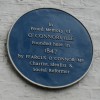Heronsgate
Heronsgate is a settlement in the county of Hertfordshire in southern England. It was founded in 1846 as a Chartist community and named O’Connorville after its founder, the Chartist leader Feargus O’Connor. Its goal was to resettle industrial laborers to smallholdings to make them independent of factory owners and possibly qualify them to vote. O’Connor’s Chartist Cooperative Land Company, which founded the community with subscription funds, had its assets liquidated by Act of Parliament in 1851 and the estate was auctioned off in 1857.
Coordinates
Latitude: 51.640086996147
Longitude: -0.512226819992
Longitude: -0.512226819992


